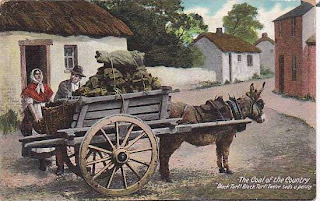 On a recent Country Standard education tour of rural Ireland, participates were interested to discover the history of one of Ireland’s most iconic farm animals, the humble Donkey, surely nothing can portray rural Ireland in bygone days as the “turf” donkey.
On a recent Country Standard education tour of rural Ireland, participates were interested to discover the history of one of Ireland’s most iconic farm animals, the humble Donkey, surely nothing can portray rural Ireland in bygone days as the “turf” donkey. While Donkey’s are now very few in number in Ireland and working donkeys even fewer still, they are still held in high affection.
However, the image we have of the working donkey's in Ireland maybe a little more recent than people may possibly imagine, for while Donkeys are believed to have been introduced to Britain by the Roman’s, only a few references refer to Donkey’s in Ireland and those date from the sixteen hundreds onwards.
It was in fact not until the Peninsula wars. The Peninsula war (1808-1814) was a war between France (Napoleon) and the allied powers of Spain , Great Britain and Portugal for control of the Iberian peninsula. (As anyone who watched the TV series Sharpe or Goya’s painting The Third of May 1808 would know.
During this War, The British army was commanded by Lieutenant-General Sir Arthur Wellesley (Later famous as the Duke of Wellington, who had been born in Ireland (24 Upper Merrion Street, Dublin now the "Merrion Hotel").
This Irish connection may also explain the staggering high statistic quoted with regard to the Irish contingent within the British Army fighting in the Peninsula war, an incredible 40% of the Army were Irish men.
A little less known fact was that huge numbers of the horses and ponies for the War also came from Ireland, indeed such was the shortage of horses in Ireland that it was forced to import large numbers of Donkey’s to replace the loss of horse power in rural areas.
This rather recent arrival of the donkey, would seem to conflict with the iconic image of the donkey in Irish life.
Until recent times, no overseas holidaymaker to in Ireland would have left without securing a post card of a donkey next to a Irish Colleen with her beautiful shawl. likewise a prized souvenir model of gold plated donkey on a plinth of Connemara Marble to go with your miniature Guinness bottle.
Today, most donkeys, even those on Irish farms are kept as reminders of bygone days.
Pic at top by kaysare Ken Rippengale
One Irish man who fought under Wellington in the Peninsula War
was David Bloomfield from
Clogher , County Tyrone, who was a Sergeant in the Cornish 32nd Foot Regiment
Clogher , County Tyrone, who was a Sergeant in the Cornish 32nd Foot Regiment
Boloomfield was a
descendant of the Bromfields sometimes spelt Brumfield and lived on a farm on
the Gledstanes family
He died aged 100 and is buried in Clogher Church of Ireland Graveyard
headstone. View from the south of the Cathedral. The inscription reads:
"Erected by Sergt. David Bloomfield, 32nd Foot, who served in the Peninsula under the Duke of Wellington. And was present at Rolera 17th Aug. 1808, Vimiero 21st Aug. 1808, Talavera 27th and 28th July 1809, Salamanca 22nd July 1812, Vittoria 21st June 1813 Pyrenees 28th 29th and 30th July 1813, Nivella 10th Nov. 1813 at which date he was severely wounded. And has now been 82 years in Her Majesty's Service. Underneath are the remains of Anne Bloomfield, his wife, who departed this life 3rd June 1870 aged 88 years. Also Sergt. David Bloomfield of Slatmore who departed this life 21st May 1882 aged 100 years."
He died aged 100 and is buried in Clogher Church of Ireland Graveyard
headstone. View from the south of the Cathedral. The inscription reads:
"Erected by Sergt. David Bloomfield, 32nd Foot, who served in the Peninsula under the Duke of Wellington. And was present at Rolera 17th Aug. 1808, Vimiero 21st Aug. 1808, Talavera 27th and 28th July 1809, Salamanca 22nd July 1812, Vittoria 21st June 1813 Pyrenees 28th 29th and 30th July 1813, Nivella 10th Nov. 1813 at which date he was severely wounded. And has now been 82 years in Her Majesty's Service. Underneath are the remains of Anne Bloomfield, his wife, who departed this life 3rd June 1870 aged 88 years. Also Sergt. David Bloomfield of Slatmore who departed this life 21st May 1882 aged 100 years."









